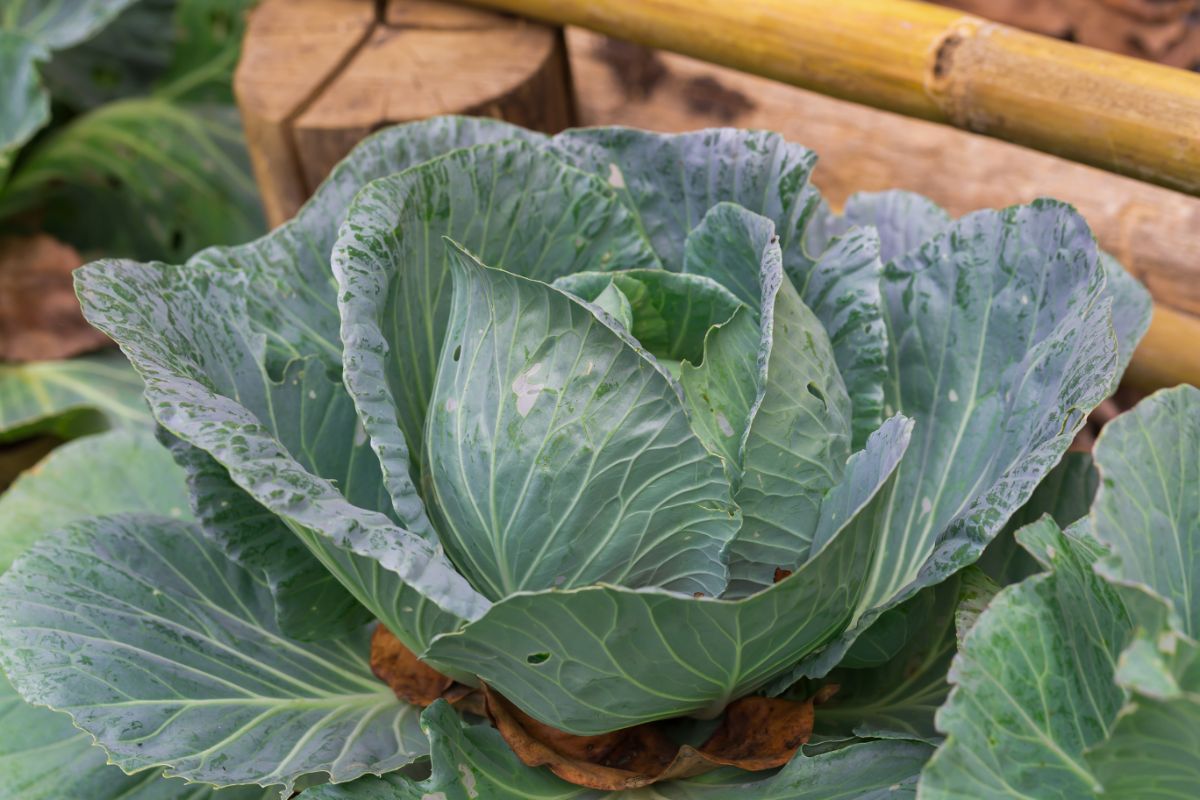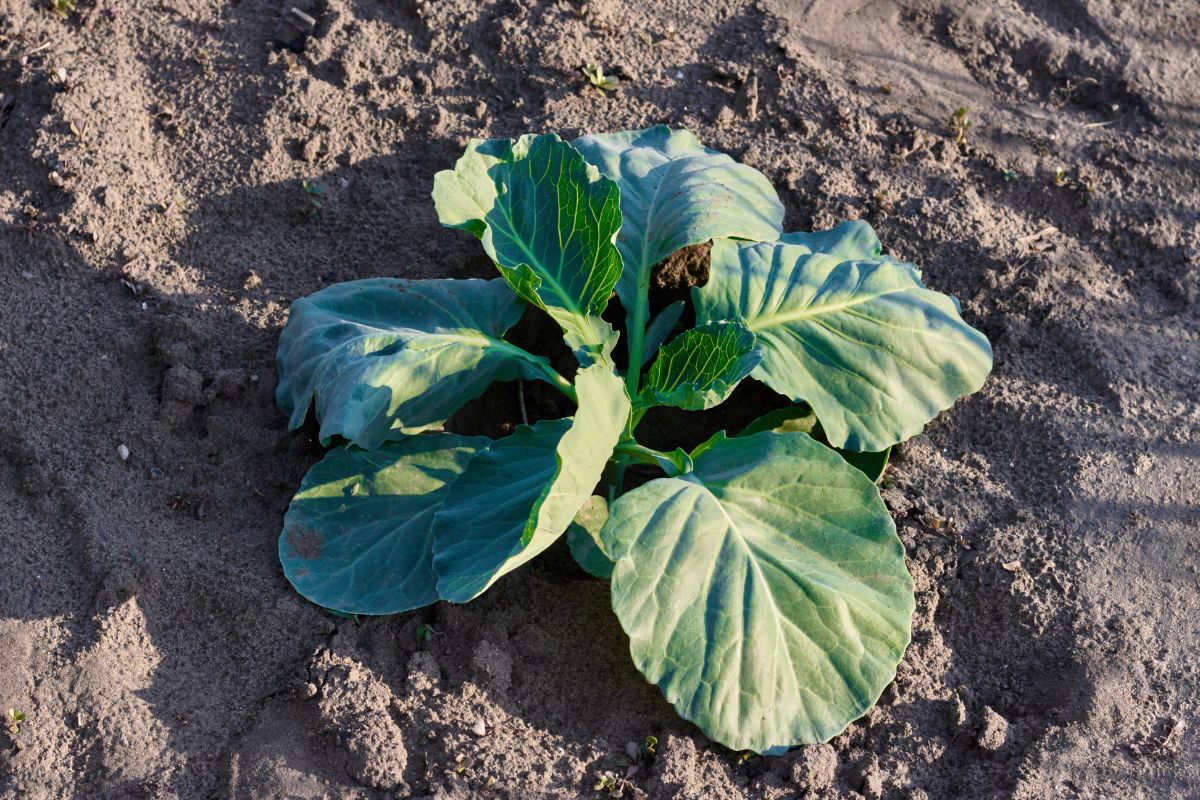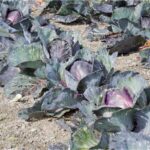Cabbage is a versatile crop that is typically propagated from seeds. However, an exciting, sustainable, and straightforward way to grow cabbage is from an existing cabbage head.
I love this option as it limits food waste and it’s fun to show the kids too.

In this guide, I will delve deeper into the process and guide you through achieving a healthy and productive cabbage plant using this method.
Benefits Of Growing Cabbage From A Cabbage Head
There are many advantages of propagating a cabbage from its own head, spanning from economic to environmental benefits, and even encompassing educational ones. Here’s a closer look at these benefits:
1. Waste Reduction
Firstly, regrowing cabbage from a cabbage head contributes to waste reduction. Instead of discarding the cabbage base after using the leaves, it can be repurposed to grow a new cabbage plant.
This is a practical application of the circular economy concept, where waste is minimised by utilising resources to their fullest potential.
2. Cost-Efficiency
Regrowing cabbage can also be a cost-saving measure. It allows you to harvest additional produce without needing to buy more seeds or seedlings.
This can be particularly beneficial for households on a tight budget or those who consume a significant amount of cabbage.
3. Environmental Sustainability
Regrowing vegetables, including cabbage, helps reduce the need for commercially grown produce, which often involves intensive farming practices.
These practices can lead to soil degradation and increased use of fertilisers and pesticides. By growing your own cabbage at home, you are promoting more sustainable agriculture practices.
4. Educational Opportunities
Regrowing cabbage from a cabbage head is an excellent educational tool, particularly for children.
It can teach them about plant life cycles, sustainability, and responsible consumption. The hands-on nature of the activity also provides an engaging way to learn and can help cultivate an interest in gardening and nature.
5. Freshness and Nutrition
Finally, homegrown cabbage has the advantage of absolute freshness.
The time from harvest to table is significantly shorter, which can lead to better taste and potentially higher nutritional content.
Homegrown produce is often free from harmful pesticides and synthetic fertilisers, making it a healthier choice for you and your family.
Necessary Supplies For Growing A Cabbage From Scraps
You will need:
- A healthy, fresh cabbage head
- A shallow dish or saucer
- Fresh water
- A sunny windowsill or similar bright spot
- A garden plot with fertile, well-draining soil or a large pot with potting soil
- Organic compost or well-rotted manure
- Mulch
- A garden trowel
- A watering can
- Organic fertiliser (optional)

Step-by-Step Guide
Step 1: Prepare the Cabbage Head
First, you’ll want to choose a robust and healthy cabbage.
Next, use a sharp knife to cut off the lower part of the cabbage, leaving about 3-5 centimetres of the base.
The cut should be flat and even to allow the cabbage to sit well in the dish.
Step 2: Place the Stump in Water
Set the cabbage stump in a shallow dish and add water – just enough to cover the base, not submerging the entire stump.
This water will help to hydrate the plant and stimulate new root growth.
Step 3: Ensure Sunlight and Monitor Water Levels
Now, take the dish and place it in a sunny spot.
Sunlight is crucial for photosynthesis, the process by which plants generate food, so it’s important the cabbage head gets enough light.
Be sure to check on water levels daily – the base should always be touching the water. To maintain freshness and prevent bacteria from forming, replace the water every couple of days.
Step 4: Observe for Roots and Leaves
After a week or two, roots and new leaves should start emerging from the cabbage’s core.
These are the first signs that your cabbage is growing.It is now ready to be transplanted if desired.
Step 5: Transplantation
I’d now recommend transplanting your cabbage to continue the growing process.
Transplanting your cabbage into soil often provides better results and a healthier plant.
If you wish to transplant it, select a garden plot or pot with well-draining soil. Enrich the soil with organic compost or well-rotted manure to introduce necessary nutrients.
Dig a hole enough to accommodate the sprouting cabbage, place the cabbage stump in, and cover it with soil, leaving the new leaves above the surface.
Step 6: Care for the Transplanted Cabbage
After transplanting your cabbage, water it regularly.
The soil should be consistently moist but not saturated. Cabbages are cool-season crops and might need some shade if the weather gets too hot.
Apply mulch around the base of the plant to help conserve soil moisture, suppress weeds, and maintain steady soil temperatures.
Regular applications of an organic fertiliser may also benefit the cabbage’s growth.
Ongoing Care And Harvesting
As your cabbage grows, continue to monitor the plant for pests and diseases.
Common cabbage pests include caterpillars, aphids, and slugs, while diseases can include clubroot and cabbage yellows.
Use organic pest control methods and rotate your crops yearly to prevent recurrent issues.
Cabbages typically take 70-120 days to mature, depending on the variety.
Harvest when the heads are firm and the cabbage has reached the size you prefer. To harvest you cabbage, cut at the base of the head with a sharp knife, leaving the outer leaves attached to the stalk.
Final Thoughts
Regrowing cabbage from a cabbage head is not just an exciting gardening experiment, but it also offers a way to reduce waste and create sustainable gardening practices.
It requires minimal supplies, and with patience and diligent care, you can successfully grow a new cabbage head from the old one.
Enjoy your homegrown, environmentally-friendly cabbage!
- Can You Grow Bell Peppers Indoors? A Guide For New Gardeners - November 14, 2023
- Composting Basics: Can You Compost Mushrooms? - November 6, 2023
- A Gardener’s Guide To Growing Carrots In Raised Beds - November 1, 2023






